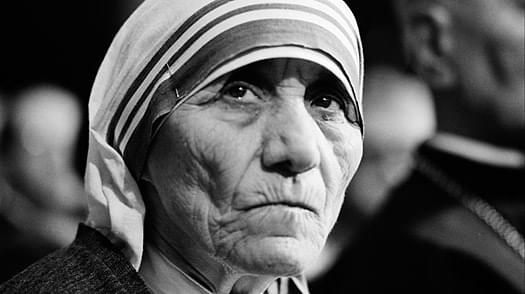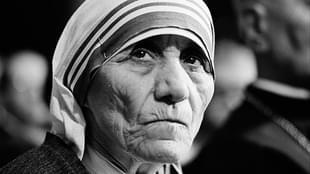Politics
The Dirt On The Saint Of The Gutters
Jayant Chowdhury
Mar 16, 2015, 12:30 PM | Updated Feb 11, 2016, 08:48 AM IST
Save & read from anywhere!
Bookmark stories for easy access on any device or the Swarajya app.


It’s high time the world accepted that Mother Teresa was a regressive religious bigot who did little good for the poor and ailing.
Now that the dust has settled over the comments made by RSS chief Mohan Bhagwat about Mother Teresa and her alleged proselytization, this is a good time to undertake a dispassionate analysis of her life and legacy. Mother Teresa, or the ‘Blessed Teresa of Kolkata’ as she is known after her beatification by the Vatican in October 2003, is undoubtedly considered by the world as a saint who gave care to lakhs of ailing and dying people and salvaged their souls. In the collective imagination of the world, she was a noble soul who dedicated her life to caring for the sick, the disabled, the homeless and the poor and, hence, a saintly soul. The Missionaries of Charity, that she established in 1950, today runs more than 500 missions in over 130 countries and is said to be the richest such order in the world, thanks to the billions of dollars that pour in from all over the world every year.
But, say Mother Teresa’s not inconsiderable number of critics, she and her order, and the work they do, is one of the biggest hoaxes created by western media-orchestrated hype. To them, Mother Teresa’s primary purpose in life was not to provide care to the sick and the destitute, but to spread the word of Christ. Mother Teresa herself said so; she hung a placard outside “Mother House” (the command centre of her order where she also resided) in Kolkata that said: “Tell them we are not here for work, we are here for Jesus. We are religious above all else. We are not social workers, not teachers, not doctors. We are nuns.”
Walter Wuellenweber argues in his incisive article in the December 22, 2006 issue of the German magazine Stern that if Mother and the sisters of the Missionaries of Charity were primarily nuns, what did they need so much money for? She once told British journalist Malcolm Muggeridge (who shared her extreme right-wing Catholic views) and was the first architect of the elaborate myth that was constructed around her: “There is always the danger that we may become only social workers. Our works are only an expression of our love for Christ”.
But it’s primarily her work that attracts the fiercest criticism. She, and the Missionaries of Charity (MoC), have been accused of not doing enough for the sick and disabled in her homes, of not utilizing the vast resources at her disposal to provide modern medical treatment to them, of diverting most of the funds received in the name of the poor to the Vatican Bank, of being opaque in financial transactions, of hobnobbing with crooks and fraudsters and accepting their ill-gotten wealth and of promoting her archaic, ultra-orthodox and dogmatic views on issues like abortion, contraception and homosexuality.
Horrible conditions at MoC homes
Former nuns and volunteers who have worked in MoC-run homes have written about the atrocious conditions at such facilities and how the sick are denied proper medical care due to Mother Teresa’s atrocious belief that “suffering was a gift from God”. Mother Teresa once told journalists: “There is something beautiful in seeing the poor accept their lot, to suffer it like Christ’s passion. I think the world is being helped by their suffering.” And so she, and her order, let the poor suffer as a matter of principle!
Doctors who have visited her homes have spoken and written about a significant lack of hygiene, proper medical care, absence of trained staff and inadequate food for the patients there. S. Bedford, a Toronto-based travel writer and journalist provided a shocking expose of conditions at Prem Dan, a MoC home in Kolkata, in the September 2014 issue of the magazine New Internationalist. The Guardian once described the care given in MoC hospices as an “organized form of neglectful assistance”. Robin Fox, the editor of British medical journal The Lancet, who visited Mother Teresa’s Home for Dying Destitute in Kolkata, criticized the medical care, or the lack of it, being provided to patients there, and held her responsible for the horrible conditions, for not making any distinction between the curable and non-curable patients and for leaving all of them to die.
Amy Gigi Alexander, who spent many years as a volunteer in Daya Dan, a MoC-run home for children with special needs in Kolkata and in MoC homes in Mexico, Guatemala, Honduras, Panama, Bolivia, Bangladesh, France, England and America since 2007, writes: “Standards for treatment were antiquated and the children often crawled around on hands and knees rather than using wheelchairs that were kept unused in a storage room”. “Mother House provided the budget for only the children’s basic needs and those needs did not include medical that was not deemed ‘necessary’. The order did not pay for things that would improve the quality of life, extend life, or make life more comfortable. Therefore, many children had had diseases that caused them to suffer, or conditions that were treatable,” she wrote.
However, when Mother Teresa herself required medical treatment, she sought and got it from the best medical facilities in America and India!
No dearth of funds
What is inexplicable is why the MoC ran, and still runs, its facilities in such a parsimonious fashion? There is no doubt that it is awash with money. An extensive study of Mother Teresa and her MoC carried out by Professor Serge Larivee and Genevieve Chenard of the University of Montreal’s Department of Psychoeducation and Carole Senechal of University of Ottowa’s Faculty of Education resulted in a paper (released two years ago) that said the MoC had raised hundreds of millions of dollars. “Mother Teresa was miserly with her foundation’s millions when it came to humanity’s sufferings. During numerous floods in India or following the leak of poisonous gas from a pesticides plant in Bhopal, she offered numerous prayers and medallions, but no monetary aid,” observed Professor Larivee.
Investigations by Stern revealed that MoC used only 7% of the donations for charity and the rest were funneled into secret bank accounts or used to build more missions. Walter Wuellenweber, in his article in Stern, quotes Susan Shields who served as Sister Virgin for nine and half years at MOC’s Holy Ghost House in New York’s Bronx, as saying that every night, 25 nuns there spent many hours preparing receipts for donations that ranged between five and a thousand dollars and during Christmas, the flow of cheques, many for 50,000 dollars and more, became “uncontrollable”. Shields was quoted as saying that one year, an MoC account in a New York bank had more than $50 million. “Fifty million dollars in one bank account in a predominantly non-Catholic country. How much then were they collecting in Europe and from around the world?” wonders Wuellenweber.
Financial opacity
Mother Teresa had consistently refused to provide any accounts of the donations she had received and how they were spent. Stern, which investigated MoC’s affairs, reported that the UK was the only country where MoC, the largest organization of its kind in the world, allowed the authorities a look at its accounts. The MoC has never issued any statement of its accounts in India, even though it is legally binding to do so and when all other similar organizations like the Ramakrishna Mission and the Bharat Sevasram Sangha regularly submit audited statement of accounts.
Walter Wuellenweber wrote that “for book-keeping, the sisters use school notebooks in which they write in cramped penciled figures. Until they (the notebooks) are full. Then everything is erased and the notebook used again!” It is mysterious why Indian authorities have not asked the MoC to submit audited accounts every year.
Hobnobbing with dictators and fraudsters
Mother Teresa flew to Haiti in 1981 to receive the Legion d’Honneur from Jean-Claude Duvalier, the maniacal dictator of that country and routinely accepted huge donations from him. She once said: “Duvalier loved the poor and their love is reciprocated”. She visited Eastern European countries during the days when they were part of the Soviet Bloc and ruled by despotic Communist regimes, accepted their hospitality and set up homes in those countries.
She accepted donations from British publisher Robert Maxwell who embezzled $450 million from his own companies’ pension funds. She also took huge sums of money from the infamous American banker and financier Charles Keating and used to travel by his private jet in the US. She infamously pleaded leniency for him when he was prosecuted for fraud, racketeering and conspiracy. She supported the Emergency imposed by Indira Gandhi in 1975 and said: “This is good. People are happier. There are more jobs. There are no strikes.”
Ultra-orthodox views
Mother Teresa harboured Catholic right-wing views on issues like abortion, contraception and homosexuality. She termed homosexuality a “scourge” and said abortion is “the worst evil”. “Abortion is a direct war, a direct killing, a direct murder by the mother of her own child. If a mother can kill her own child, what will prevent us from killing ourselves or one another?” she once said. In the context of the 1971 Bangladesh Liberation War, when an estimated 45,000 women were raped by Pakistani army, she said the women should keep their babies.
There have been quite a few critical books and films made on Mother Teresa. One of the most well-researched among them is one by Aroup Chatterjee, a London-based physician, who worked in one of Mother Teresa’s homes. His The Final Verdict is a damning indictment of Mother Teresa and her work. Based on his book, British journalists Christopher Hitchens and Tariq Ali produced a documentary, Hell’s Angel, for BBC’s Channel 4. Hitchens also wrote the well-known book The Missionary Position: Mother Teresa In Theory and Practice, that blew many myths around the nun. Hitchens puts it succinctly when he says: “Mother was not a friend of the poor, but a friend of poverty. She said that suffering was a gift from god. She spent her life opposing the only known cure for poverty—empowerment of women and their emancipation from a livestock version of compulsory reproduction”.
Aroup Chatterjee points out that of the few hundred charitable organizations working for the poor, destitute and ailing in Kolkata, the MoC is one of the largest in terms of size and number of nuns, workers and volunteers, but caters to a very small percentage of the people who need help. Even other Christian organizations do much more. Organisations like the Ramakrishna Mission routinely cater to a few times the number of poor and ailing that the MoC does, despite having much lesser funds.
In the ultimate analysis, a lot of that aura surrounding Mother Teresa and her order is a myth created by the media and the Catholic Church which sees in her beatification and eventual canonization the perfect means to revitalize the Church at a time when churches are empty and the Vatican’s authority on the decline. And for many in the western world, Mother Teresa reinforces their deep-seated prejudices that it is ultimately the white man (or woman) who provides succour to the unwashed, heathen masses of the “brown” and “black” world. She made westerners feel good that they still are the saviours of the world.
Jayant Chowdhury is an avid observer of and commentator on politics and society in Bengal and eastern, including north-eastern, India.





